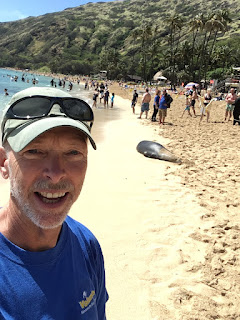Hawaiian monk seal adventure at Hanauma Bay
While Caroline and the Wanderlust yoga group drove to Ko Olina to snorkel, I headed over to the Hanauma Bay Nature Preserve to volunteer for a few hours. The weather was... perky. Windy, rainy, and cool. I parked in the staff lot and walked to the education program office. On the way, I noticed a number of birds feeding on a piece of bread in the parking lot.
Let's see... cattle egrets (introduced), zebra doves (introduced), myna bird (introduced), and a chicken (introduced). Not a great start for visiting a nature preserve! And with the cats and the mongoose (more introductions), I wondered again about the city's ability to manage this area. The only non-human species I know somebody is attempting to manage is cats, with some restrictions on feeding and I believe a more concerted attempt to manage the cats as a TNVR colony.
Last week there was a report of a critically ill Hawaiian monk seal on Oahu infected with the Toxoplasma gondii parasite.
I had a letter to the editor in the Star-Advertiser published following this report:
Dear Editor:
It is terribly sad that the monk seal R028 has been infected
with the parasite Toxoplasma gondii (“Monk seal at Ko Olina suffers from
disease spread by feral cats,” Star-Advertiser, Feb. 4). Her condition is
serious and guarded, and I hope she makes a full recovery. Unfortunately, this
report will spawn another round of rhetoric against feral cat
trap-neuter-return (TNR) programs, where feral cats are spayed or neutered and
returned to their capture site, even though the number of surgically sterilized
feral cats in these programs is but a small fraction of the total number of
feral cats on Oahu. I hope people interested in protecting monk seals from
toxoplasmosis avoid releasing unwanted cats into the wild, don’t let their
domestic cats roam outside, and support programs to spay and neuter cats,
including organized TNR programs.
I've blogged about this issue before. According to NOAA, "the population is estimated to be around 1,400 seals—about 1,100 seals in the Northwestern Hawaiian Islands and 300 seals in the main Hawaiian Islands." Thank goodness the situation isn't as dire as for the vaquita in Mexico, a small porpoise with a population below 30, and perhaps as few as 19. Regardless, a worldwide population of 1400 is still worrisome, and conservationists are rightly concerned about each and every individual.
Regarding monk seals and people, NOAA literature states, "Intentional feeding, disturbance of sleeping or resting seals, and/or other direct human interactions, such as swimming with juvenile seals, has become a serious concern for the main Hawaiian Islands population. Beaches that are popular for human recreation are increasingly used by monk seals for "hauling out" (resting) and molting, and some female monk seals are also pupping on popular recreational beaches. During these pupping events, mother-pup pairs remain on the beach to nurse for up to 7 weeks, at which time they're particularly vulnerable to human disturbance. This also presents a serious human safety concern, as mother seals are protective and aggressive. Human-seal interactions pose both a threat to human and seal safety and have necessitated the relocation of "conditioned" seals to remote locations in some cases."
So, when monk seals haul out on popular beaches, volunteers often cordon off the area to allow the seals some privacy. Hanauma Bay is visited by monk seals on a regular basis.
Today, I was working the upper visitor area, guiding people toward the mandatory video presentation in the theater. All visitors, residents and tourists alike, are required to view this video once per year before they are allowed to access the beach at Hanauma Bay. The video focuses on safety for people, and conservation of the reef.
I noticed a group of excited people pointing down to the beach, and I heard somebody mention the word, "seal." Here's what I saw when I looked over the wall:
Guess what is in the middle of that crowd? Yes, a monk seal. These people are way too close, for safety reasons. The Hawaii Marine Animal Response website notes that if no signs, ropes or authorized personnel are in the vicinity, it is recommended that you stay at least 50 feet from Hawaiian monk seals and 150 feet if you encounter a mother monk seal with a pup. Obviously, these people are closer than 50 feet. I had a security guard wonder if there was anybody available to protect the seal. It was raining, so I put my bright red raincoat on and headed down to the beach. I knew where the monk seal fencing was (signs, ropes), so I picked them up and went toward the seal. I politely encouraged people to stand back, and started pushing the stakes with signs into the sand. In a few minutes, two park attendants joined me, and we kept the crowd at bay until a HMAR volunteer showed up.
I was there for about an hour, doing my part! I do have to mention that when one volunteer started pounding the signs into the sand with a rock (I had only pushed them in), the seal looked up at each pounding. No disturbance means no disturbance, whether by visitors or staff.
I was asked about the seal's history, and I knew nothing. There was no obvious tag. I guessed it was a pregnant female because it looked nice and plump, but the only thing I was certain about was that it was a Hawaiian monk seal, and sleeping on the beach. This was only the tiniest, tiniest fraction of effort toward monk seal conservation, but I'm glad I helped.
Not a bad way to spend a Wednesday morning!












Comments
Post a Comment